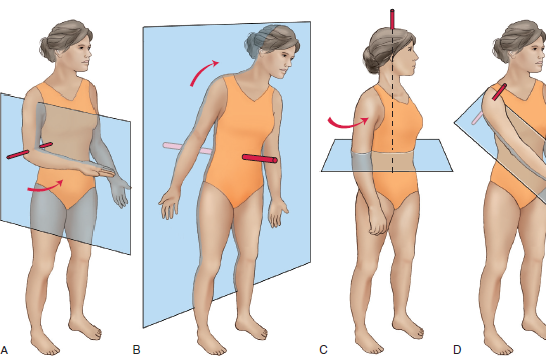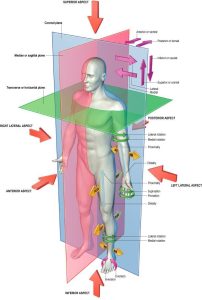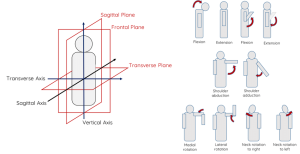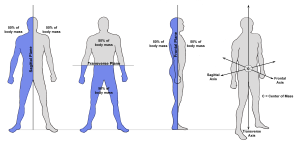Planes & Axes of Movement

Planes & Axes of Movement
Understanding the planes and axes of movement is fundamental in anatomy and biomechanics, particularly in the context of human movement and exercise science. These concepts help describe and analyze the various motions that occur in the human body. There are three main anatomical planes and three corresponding axes of movement. Let’s delve into each of them:
Anatomical Planes: Anatomical planes are imaginary flat surfaces used as reference points for describing body movements. These planes divide the body into different sections, making it easier to visualize and understand motion.
- Sagittal Plane:
- The sagittal plane is a vertical plane that divides the body into left and right halves.
- Axis of movement: The axis of movement for the sagittal plane is the frontal or coronal axis, which runs horizontally from side to side.
- Motions in the sagittal plane include flexion and extension.
- Flexion: Bending or decreasing the angle at a joint. For example, bending the elbow or knee.
- Extension: Straightening or increasing the angle at a joint. For example, straightening the elbow or knee.
- Frontal Plane:
- The frontal plane is a vertical plane that divides the body into front (anterior) and back (posterior) halves.
- Axis of movement: The axis of movement for the frontal plane is the sagittal axis, which runs horizontally from front to back.
- Motions in the frontal plane include abduction and adduction.
- Abduction: Moving a body part away from the midline of the body. For example, raising the arm to the side.
- Adduction: Moving a body part toward the midline of the body. For example, lowering the arm back to the side.
- Transverse Plane:
- The transverse plane is a horizontal plane that divides the body into upper (superior) and lower (inferior) halves.
- Axis of movement: The axis of movement for the transverse plane is the longitudinal axis, which runs vertically from top to bottom.
- Motions in the transverse plane include rotation.
- Rotation: Turning or twisting of a body part around its longitudinal axis. For example, rotating the head from side to side.

- Rotation: Turning or twisting of a body part around its longitudinal axis. For example, rotating the head from side to side.
Axes of Movement: Axes of movement are imaginary lines that run perpendicular to the planes of motion and define the axis around which specific movements occur.
- Frontal (Coronal) Axis:
- The frontal axis runs horizontally from side to side and is perpendicular to the sagittal plane.
- Movements around this axis occur in the sagittal plane.
- Examples of movements around the frontal axis include flexion and extension.
- Sagittal Axis:
- The sagittal axis runs horizontally from front to back and is perpendicular to the frontal plane.
- Movements around this axis occur in the frontal plane.
- Examples of movements around the sagittal axis include abduction and adduction.
- Longitudinal (Vertical) Axis:
- The longitudinal axis runs vertically from top to bottom and is perpendicular to the transverse plane.
- Movements around this axis occur in the transverse plane.
- Examples of movements around the longitudinal axis include rotation.

Understanding the planes and axes of movement is essential for biomechanical analysis, sports science, physical therapy, and designing effective exercise programs. These concepts help professionals and enthusiasts alike assess and enhance movement patterns, flexibility, strength, and overall physical performance.
Here’s how planes and axes of movement are relevant in exercise:
- Exercise Selection: Knowing the planes and axes helps in selecting exercises that target specific muscle groups or movements. For example:
- If you want to work on the muscles involved in hip abduction (moving the leg away from the midline), exercises in the frontal plane, such as lateral leg raises, would be appropriate.
- For strengthening the quadriceps and performing knee extension (straightening the leg), exercises in the sagittal plane, like leg extensions, are suitable.
- To improve core rotation, exercises involving trunk rotation in the transverse plane can be chosen.
- Exercise Variation: Understanding planes and axes allows for exercise variation to prevent overuse injuries and promote balanced muscular development. Rotating exercises across different planes and axes can prevent muscle imbalances and reduce the risk of repetitive strain injuries.
- Biomechanical Analysis: Trainers and therapists use knowledge of planes and axes to analyze movement patterns. This analysis helps identify faulty movement mechanics or limitations that may lead to injuries. It also guides the selection of corrective exercises.
- Customized Workouts: Personal trainers can use this knowledge to design customized workouts tailored to an individual’s specific goals and needs. Whether the goal is rehabilitation, improving sports performance, or general fitness, exercises can be chosen to target the desired planes and axes.
- Injury Prevention: Understanding how different exercises affect the body in different planes can aid in injury prevention. For example, knowing the mechanisms of ACL (anterior cruciate ligament) injuries can lead to the design of exercises that reduce the risk of such injuries by strengthening muscles and improving joint stability in the frontal and transverse planes.
- Sports Specificity: In sports science, the choice of exercises is often determined by the specific movement patterns required in a sport. Athletes may train in movements that mimic their sport, focusing on the planes and axes relevant to their activities.
- Functional Training: Functional training aims to improve everyday movements. Understanding planes and axes helps in designing functional exercises that mimic real-life activities, enhancing overall functional fitness.
- Range of Motion (ROM): Knowledge of planes and axes is essential for assessing an individual’s range of motion at various joints. This information guides the design of stretching and mobility exercises to improve flexibility and joint mobility.
- Core Strengthening: The core plays a vital role in stabilizing the body during movement. Exercises that engage the core muscles often involve movements in multiple planes, and trainers can choose exercises that challenge core stability effectively.
- Rehabilitation: In physical therapy and rehabilitation settings, understanding planes and axes helps therapists design exercise protocols that facilitate recovery and improve functional movement.

